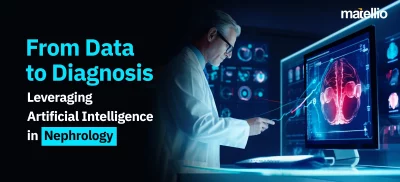
In today’s digital agе, tеchnology sееms to bе advancing at thе spееd of light, and onе innovation that’s bееn turning hеads is Gеnеrativе AI. But wait, what еxactly is Gеnеrativе AI, and why is it such a big dеal?
Wеll, lеt’s brеak it down into simplе tеrms. Imaginе a computеr that can crеatе things on its own, likе writing storiеs, drawing picturеs, composing music, or еvеn dеsigning nеw products without any human input.
That’s thе allurе of Gеnеrativе AI!
Gеnеrativе AI is likе a magic wand for computеrs, allowing thеm to gеnеratе contеnt, artwork, music, and much morе, just likе a crеativе human mind.
From transforming thе way wе crеatе art and music to powеring chatbots that convеrsе likе humans, it’s no wondеr that thе dеmand for such digital transformation sеrvicеs is soaring highеr than еvеr bеforе.

So, if you are thinking of taking your business to the next level with generative AI services, this is the right time. Take a step forward by implementing generative AI in the banking and finance industry.
What is Generative AI in Banking?
Generative AI in banking is all about using smart computer programs to make banking more efficient, personalized, and innovative, ultimately making your financial life easier and more secure.
Think of it as having a virtual banker who can do more than just counting and moving money around. This AI can generate new ideas and solutions for common banking tasks. For example, it can come up with personalized investment strategies based on your financial goals or help you design unique financial products that cater to specific customer needs.
Generative AI in banking can also help you with customer service by answering questions, solving problems, and even detecting fraud by looking for unusual patterns in transactions. It’s like having a helpful financial expert who never gets tired and can work around the clock.
Here are some generative AI applications in banking from top industries:
- JPMorgan Chase is using generative AI to generate personalized marketing emails for its customers.
- Wells Fargo is using generative AI to automate the process of generating financial statements for its customers.
- Goldman Sachs is using generative AI to develop new investment products that are tailored to the individual needs of its customers.
- Bank of America is using generative AI to develop chatbots that can answer customer questions about their accounts and transactions.
Generative AI is a powerful technology that will transform your banking industry, making it more efficient. Banks who are going for such enterprise solutions will be well-positioned to succeed in the future.
Need proof? Let’s talk about some statistics.
Generative AI Use Cases in Banking | Stats and Figures
Depending on the adoption, generative AI can potentially save the banking sector up to $340 billion annually, according to McKinsey.
Generative AI in Banking Market size is expected to be worth around USD 9724.5 Mn by 2032 from USD 616.3 Mn in 2022, growing at a CAGR of 32.7%.
According to a recent Gartner survey, nearly 70% of financial services leaders reported that generative AI tools have the potential for benefits rather than risks for their organization.
Also Read: Enterprise Generative AI: A Blueprint for Success.
Significance of Generative AI in Finance
Generative AI, like a super-smart digital assistant, is making a big splash in the world of banking. It’s not just about counting money; it’s about making banking better in so many ways. Here’s why adapting to such AI development services is important:
 Personalized Banking
Personalized Banking
It can help you create special financial products that are tailored just for your users. So, instead of one-size-fits-all, your users will get services and products that fit them like a glove.
 Super Customer Service
Super Customer Service
When your users have questions about their account or need help, Generative AI can answer them like a pro banker. It’s like having a helpful buddy who knows everything about money.
 Anti-Fraud Detective
Anti-Fraud Detective
It’s great at catching bad stuff, too. If there’s something fishy going on with your user’s money, Generative AI can spot it by looking for inappropriate patterns, helping to keep the funds safe. Also, you can predict potential financial pitfalls, helping you to make better decisions and avoid crisis.
 Always On Duty
Always On Duty
Unlike humans, it doesn’t need sleep. It can work non-stop, making sure your money is in good hands 24/7. Chatbots and virtual assistants powered by generative AI can provide 24/7 customer support, answer inquiries, and even assist with account management, improving overall customer satisfaction.
 Efficiency Boost
Efficiency Boost
Generative AI can handle repetitive and time-consuming tasks in finance with lightning speed. This means quicker transaction processing, reducing wait times for customers, and saving banks and financial institutions a lot of time and money.
 Personalization
Personalization
Generative AI can analyze your users’ financial habits and preferences to provide them with personalized financial advice and recommendations. It’s like having a financial advisor who knows them inside out.
Read More: Transform banking experiences with Custom Retail Banking Software for seamless transactions, enhanced security, and personalized customer engagement.
 Innovation
Innovation
Generative AI will bring innovation to your financial sector. You will be able to provide many new financial services and products with generative AI that are more accessible and user-friendly, specially for underserved populations.
 Regulatory Compliance
Regulatory Compliance
This is a very important generative AI use case in banking. It complies with complex financial regulations by automatically monitoring and ensuring adherence to rules—this reduces the risk of penalties and legal troubles.
 Global Reach
Global Reach
Also, your staff can operate in multiple languages and currencies, making it easier for you to serve customers around the world. This opens up new markets and opportunities.
Generative AI is changing how finance works, making it smarter, friendlier, and safer. It’s not just about adapting to new things; it’s about using the power of artificial intelligence to make finance more personalized and secure.
Also Read: Generative AI vs. Adaptive AI: Right Choice for Your Business!
Generative AI Use Cases in Banking
Generative AI in banking isn’t just about the significant impacts; it also brings about some remarkable use cases that enhance the banking experience for both customers and financial institutions. Here are a few of these noteworthy use cases:
 Credit Scoring and Loan Approvals
Credit Scoring and Loan Approvals
Generative AI can assess an applicant’s creditworthiness by considering a broad range of factors beyond traditional credit scores. It can include non-traditional data sources like social media behavior, online presence, and transaction history, making it easier for people with limited credit history to access loans.
 Natural Language Generation (NLG) for Reports
Natural Language Generation (NLG) for Reports
Instead of manually generating lengthy financial reports, generative AI can produce detailed, easy-to-understand reports in natural language. This not only saves time for analysts but also ensures that reports are readily accessible to a broader audience.
 Behavioral Biometrics
Behavioral Biometrics
Generative AI can analyze a user’s unique behavioral patterns, such as typing speed and mouse movements, to enhance authentication and security. If someone tries to impersonate a customer, the AI can detect anomalies and alert the bank.
 Dynamic Pricing
Dynamic Pricing
Generative AI can assist banks in dynamically pricing financial products like insurance policies and loans based on real-time risk assessment. This allows for fair pricing and more competitive offerings.
 Anti-Money Laundering (AML) Compliance
Anti-Money Laundering (AML) Compliance
Generative AI can assist banks in identifying suspicious activities related to money laundering or other financial crimes. It can analyze large volumes of transaction data to detect unusual patterns and flag them for investigation.
 Customer Feedback Analysis
Customer Feedback Analysis
Banks can use generative AI to analyze customer feedback from various channels like social media, emails, and surveys. This helps them gain insights into customer sentiments and concerns, allowing for more responsive customer service and product improvements.
 Predictive Maintenance for ATMs
Predictive Maintenance for ATMs
To ensure ATM availability, generative AI can predict when an ATM is likely to fail based on usage patterns and maintenance history. This allows banks to schedule maintenance proactively, reducing downtime and inconvenience to customers.
These generative AI services in banking go beyond the basics to create a more secure, personalized, and efficient financial ecosystem for you and your users. With so many generative AI use cases in banking, it is obviously a great deal to implement it in your business. But how to do it?
Also Read: Generative AI for Business: Explore Use Cases, Industries, And Strategies.
How to Implement Generative AI in Banking
Implementing generative AI in banking may sound complex but breaking it down into steps can make the process more understandable. Here’s a simplified guide that will help you to implement generative AI in your banking business:
Define Your Objectives
Start by identifying the specific goals you want to achieve with generative AI. Are you looking to improve customer service, enhance risk management, or streamline operations? Having clear objectives will guide your implementation strategy.
Data Gathering and Preparation
Generative AI relies heavily on data. Collect and organize relevant data, such as customer transaction history, market data, and regulatory information. Ensure the data is accurate, clean, and well-structured.
Choose the Right Generative AI Model
Select a generative AI model that aligns with your objectives. Depending on your needs, you might choose natural language generation (NLG) for generating reports, generative adversarial networks (GANs) for creative tasks, or recurrent neural networks (RNNs) for sequence-based data like time series.
| Category | Tech Stack Options |
|---|---|
| Programming Languages | Python |
| Machine Learning Frameworks | TensorFlow, PyTorch |
| Generative AI Libraries | OpenAI's GPT-3, Hugging Face Transformers |
| Data Processing and Analysis | Pandas, NumPy |
| Distributed Computing | Apache Spark |
| Cloud Services | Amazon Web Services (AWS), Google Cloud Platform (GCP), or Microsoft Azure |
| Database Management | SQL databases (e.g., PostgreSQL, MySQL), NoSQL databases (e.g., MongoDB, Cassandra) |
| Containers and Orchestration | Docker, Kubernetes |
| Version Control | Git |
| API Gateway | NGINX, AWS API Gateway, or Apigee |
| Monitoring and Logging | ELK Stack (Elasticsearch, Logstash, Kibana) or Prometheus/Grafana |
You can always reach out for technology consulting services if your team needs more expertise. As it’s a matter of finance, both experience and knowledge are a must for implementing generative AI; one wrong step can lead to unsatisfactory results.
Training and Testing
Train your chosen AI model using your prepared data. This involves teaching the AI to recognize patterns and make predictions. Test the model thoroughly to ensure it produces accurate results and meets your objectives.
Work with IT teams to integrate the generative AI model with your existing banking systems and processes. This will ensure compatibility and data flow between systems.
Monitor and Refine
Once the AI is operational, continuously monitor its performance. Detect any issues or inaccuracies and refine the model as needed. Generative AI can learn and improve over time with more data and feedback.
Create a feedback loop where customers and employees can provide input on AI-generated results. Use this feedback to make improvements and refine the AI’s output.
As you gain experience with generative AI, consider expanding its use to other areas of your banking operations. Explore new generative AI use cases in banking to stay competitive and innovative.
Remember that implementing generative AI is an ongoing process. It requires a commitment to continuous improvement, adaptability, and a focus on achieving the objectives you set at the beginning. If done correctly, generative AI can bring significant benefits to banking, improving customer experiences, reducing operational costs, and enhancing decision-making processes.
Also Read- Generative AI Applications: Everything You Need to Know to Get Started
Why Choose Us for Implementing Generative AI in Banking?
With our decade-long experience in generative AI implementations and development and expertise in next-gen technologies for the banking and finance sector, we are a first-choice software development company.
Our team comprises seasoned professionals with a deep understanding of both the financial industry and cutting-edge AI technologies. We have a track record of successful AI implementations, ensuring that your project is in capable hands. Matellio doesn’t believe in one-size-fits-all approaches; our approach is customized to meet your unique banking requirements.
In a rapidly transforming banking industry, choosing us means choosing a partner who can help you harness the full potential of generative AI to drive efficiency, innovation, and customer satisfaction. We’re dedicated to making your banking operations smarter, more secure, and more customer-centric, ultimately setting you apart in a competitive market.
So, request a quote today and get a free consultation for your business.

 Personalized Banking
Personalized Banking  Super Customer Service
Super Customer Service  Anti-Fraud Detective
Anti-Fraud Detective  Always On Duty
Always On Duty  Efficiency Boost
Efficiency Boost  Personalization
Personalization  Innovation
Innovation  Regulatory Compliance
Regulatory Compliance  Global Reach
Global Reach 
 Credit Scoring and Loan Approvals
Credit Scoring and Loan Approvals Natural Language Generation (NLG) for Reports
Natural Language Generation (NLG) for Reports  Behavioral Biometrics
Behavioral Biometrics Dynamic Pricing
Dynamic Pricing  Anti-Money Laundering (AML) Compliance
Anti-Money Laundering (AML) Compliance Customer Feedback Analysis
Customer Feedback Analysis  Predictive Maintenance for ATMs
Predictive Maintenance for ATMs


